
Bioscience Institute
Pioneering Advanced Technologies for Longevity
Since 2007, Bioscience Institute has established itself as an international leader in cellular and molecular biology services, operating state-of-the-art sequencing platforms and GMP cell factories in Italy and the UAE. As a spin-off of the University of Rome, the Bioscience Institute specializes in Genomics for sequencing of cfDNA, mesenchymal stem cell and exosome culture for advanced personalized therapies that are critical for addressing degenerative processes caused by aging or pathological conditions. The procedures for extraction, expansion, and banking of stem cells and exosomes are performed in laboratories based in Dubai and Italy, while the Genomics in Rome.
The services of the Bioscience Institute are unique as they offer the most advanced stem cell and exosome therapies for any age-related defects. Bioscience Institute has developed revolutionary protocols for sequencing circulating DNA, designed to identify the drivers of aging and associated diseases. This breakthrough enables precision preventive medicine tailored to individual needs. Their proprietary technology can detect minute genetic variations that contribute to cellular senescence and tissue degradation, allowing for early intervention before clinical symptoms manifest. The combination of two areas of expertise, stem cells and cfDNA sequencing, has positioned Bioscience Institute as the leading company in the field of longevity.
GENOTOXICITY
The primary driver of aging
BIOXPACE is an innovative method developed by BIOSCIENCE INSTITUTE, focusing on the study of genotoxicity accumulation and the management of stem cell exhaustion in human organs and tissues. This protocol is designed not only to extend lifespan but also to improve its quality, offering the possibility of aging in a healthier way.
Biomolecular aging is primarily influenced by interactions between genes and environmental factors that cause DNA damage. As age progresses, the efficiency of DNA repair mechanisms, known as DNA Damage Response, decreases. Every day, DNA undergoes between 10,000 and 20,000 damage events, most of which are effectively repaired by cellular mechanisms. However, unrepaired damage tends to accumulate, leading to a condition of genotoxicity that compromises genomic stability and accelerates aging processes.

BAD HABITS THAT PROMOTE GENOTOXICITY

The approach proposed by the BioXpace protocol allows for the development of personalized medical strategies aimed at strengthening DNA repair and preventing significant damage accumulation, driver of genotoxicity.
Throughout life, physiological conditions change due to the accumulation of genotoxic damage from environmental pollution, lifestyle choices, and natural cellular processes.
This build-up of genotoxicity increases the number of senescent cells, which lose their ability to proliferate and release inflammatory signals, leading to systemic inflammation.
The immune system, which normally helps restore balance by eliminating senescent cells to reduce inflammation, becomes dysfunctional under continuous stress and fails to function properly.
The effectiveness of the immune system is also closely linked to the balance of the gut microbiome, which influences its protective capabilities.
GENOTOXICITY
THE CAUSE OF DEGENERATIVE PROCESSES
is the progressive accumulation of DNA damage (from physical, chemical and radiation sources) that cannot be repaired and causes aging by lowering the concentration and functionality of stem cells in tissues and organs, reducing the body’s regenerative functions and promoting the aging processes.
Somatic Passenger Mutations
Silent Genetic Scars
Numerous and mostly neutral DNA alterations that accumulate with age
Damage Record
Serve as a record of lifetime exposure to GENOTOXIC influences
Collective Impact
They impair cellular functions and can lead to tissue dysfunction or age-related decline in organ function
Inherited Genetic Predisposition
What It Measures
Analysis of inherited germline mutations that predispose individuals to age-relateddiseases
Role in Aging
Germline defects in DNA repair cause aging syndromes and influence the body’s maintenance systems
Clinical Relevance
Helps personalize assessment and interventions. Individuals require different frequency of monitoring base on predisposition
Genotoxicity and Oxidative Stress
Measurable Damage
This test measures INDICATING DNA BASE OXIDATION, protein carbonyls, and lipid peroxides
Aging Engine
ROS cause cumulative damage to DNA, proteins, and cell membranes. A high oxidative stress burden means the aging engine is running hot
Disease Link
Individual’s oxidative stress levels provides insight into how aggressively fundamental aging processes are occurring
Senescent Cells: The Zombie Cells of Aging
Senescent cells secrete inflammatory factors known as SASP (Senescence-Associated Secretory Phenotype). The SASP creates “sterile” inflammation, which accelerates aging and promotes disease in multiple organs, such as the liver and kidneys, where it contributes to fibrosis and organ failure. When immune clearance is ineffective due to an imbalanced immune system, senescent cells persist and spread throughout the body, promoting low-grade inflammation and related degenerative processes.
Immune System Deficiency & Senolytic Surveillance
IMMUNE CELL AGING
With age, immune cells show signs of exhaustion and dysfunction. This includes reduced naive T-cell counts, accumulation of late-differentiated T cells, and decreased proliferative responses to stimuli, collectively known as immunosenescence.
SENOLYTIC FUNCTION
Natural killer cells play a crucial role in eliminating senescent cells. NK cells recognize “alarm” signals on senescent cell surfaces and destroy them. This cleaning function prevents accumulation of damaged cells that could contribute to tissue dysfunction.
DNA DAMAGE RESPONSE
THE GENOMIC GUARDIAN AGAINST AGING
aims to accurately repair DNA and restore its original sequence, but this process isn’t infallible. Errors in repair lead to somatic mutations irreversible changes resulting in GENOMIC INSTABILITY and GENOTOXICITY.
Enhancing DNA Damage Response: A Strategy for Longevity
Monitoring Efficiency
Systems like HELIXBALANCE evaluate DNA repair mechanisms and provide crucial insights into genomic stability maintenance.
Targeted Intervention
Improving deficiencies within repair system can prevent the onset and progression of aging and age-related diseases.
Preventive Approach
Strengthening the DDR is a vital strategy in promoting long-term health, focusing on preventing the accumulation of molecular damage.
The Hidden Impact of Micro/Nanoplastics burden
The Pro-Inflammatory Cytokines
IL-17A – TNF-α – IL-6 – IL-4 – IFN-γ – IL-12 – IL10 – C-REACTIVE PROTEIN
Master inflammatory cytokine produced by immune and senescent cells. Causes DNA damage through ROS generation and suppresses telomerase activity. Prototypical SASP cytokine strongly associated with frailty and mortality. Impairs DNA repair and maintains senescence in neighboring cells.
Gut Microbiome Balance - The Gut-Immune-Brain Axis
Microbiome Changes
With age, beneficial bacteria decline while pro-inflammatory species increase. This shift can lead to reduced production of beneficial metabolites like short-chain fatty acids and increased production of inflammatory compounds.
Gut Barrier Dysfunction
A dysbiotic microbiome weakens the intestinal barrier, leading to “leaky gut.” This allows bacterial products like lipopolysaccharide (LPS) to enter circulation, triggering systemic inflammation.
Immune Activation
LPS and other microbial compounds activate immune cells, leading to production of pro-inflammatory cytokines. This chronic immune activation contributes to inflammaging.
Systemic Effects
Inflammatory signals travel throughout the body, affecting distant organs including the brain. This can contribute to neuroinflammation and potentially accelerate neurodegenerative diseases like Alzheimer’s.
GENOTOXICITY ASSESSMENT
AGE-RELATED GENETIC PREDISPOSITION GERMINAL MUTATIONS
Understanding an individual’s genetic predisposition to developing age-related diseases guides personalized preventive measures to mitigate associated risks.
GENOMIC INSTABILITY SOMATIC CANCER DRIVER MUTATIONS
Identifies the progressive accumulation of somatic mutations in genes that actively drive the development of cancer and contribute to the overall instability.
GENOMIC INSTABILITY SOMATIC PASSENGER MUTATIONS
Passenger mutations are signs of genomic instability and reflect the history of the cell’s exposure to genotoxic stresses. They assess the impact of environmental and endogenous genotoxic factors.
CLONAL HEMATOPOIESIS OF INDETERMINATE POTENTIAL (CHIP)
Associated with an increased risk of hematologic cancer, cardiovascular disease, and age-related conditions. The presence of CHIP is an indicator of genomic instability in hematopoietic cells.
MICRO/NANO PLASTIC ANALYSIS AND QUANTIFICATION
Micro/nanoplastics disrupt biological pathways by mimicking or interfering with hormones, causing inflammation, or even carrying other toxins into cells.
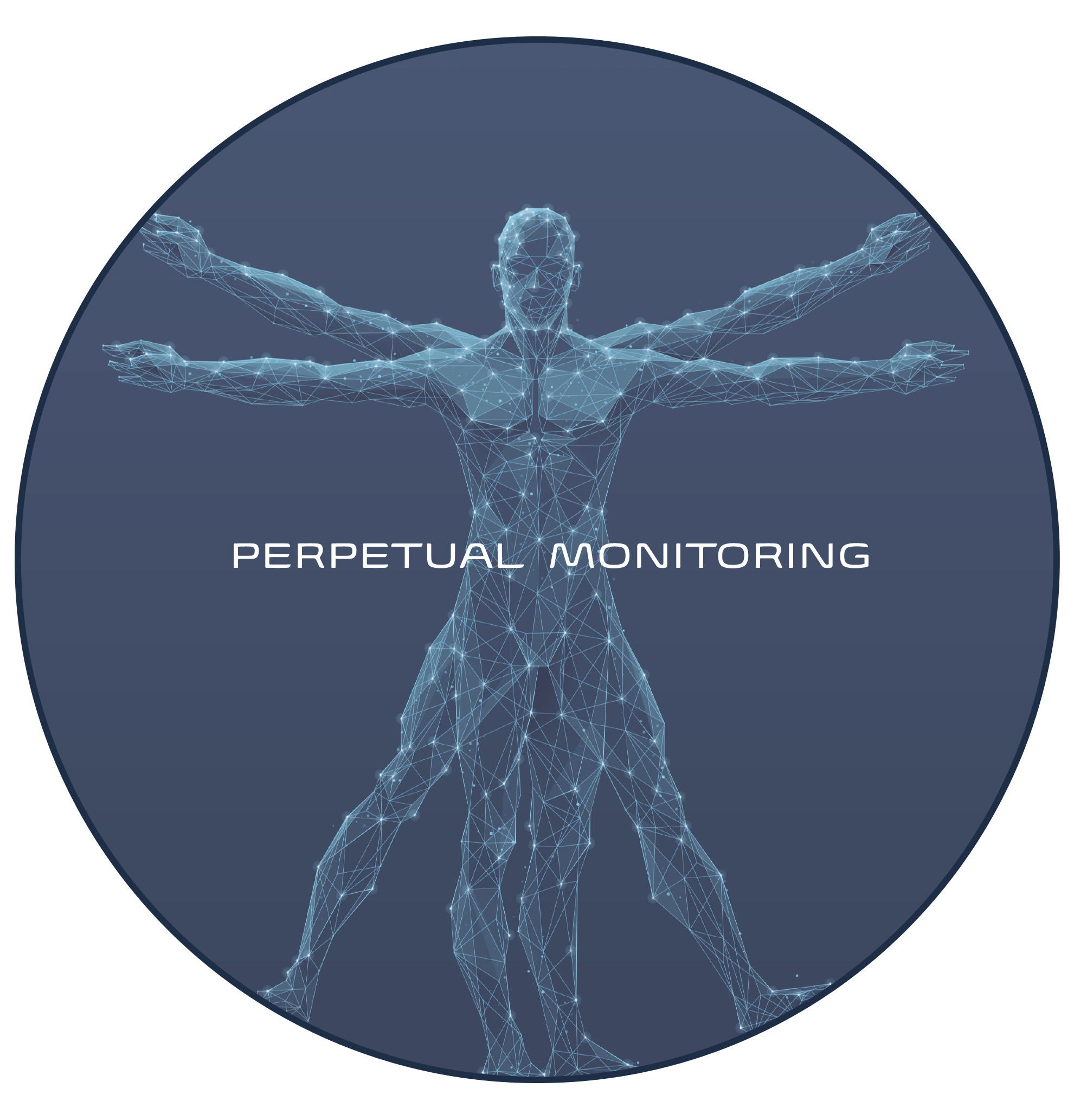
DNA DAMAGE RESPONSE EFFICIENCY
SENESCENT CELLS AND SENESCENCE-ASSOCIATED SECRETORY PHENOTYPE ACCUMULATION
Senescent cells lead to tissue dysfunction and promote chronic diseases associated with aging. Identifying the accumulation is critical for implementing senolytic therapies that clear the cells.
GENOTOXICITY AND OXIDATIVE STRESS
This refers to the level of damage caused by genotoxic agents, which can lead to mutations and cellular aging implicated in various degenerative diseases.
LOW-GRADE SYSTEMIC CHRONIC INFLAMMATION
Testing for biomarkers of inflammation helps determine the extent of inflammation and facilitate strategies to reduce inflammation and its effects on aging.
IMMUNE SYSTEM DEFICIENCY IN IMMUNE CLEARANCE
Evaluates the immune response to rejuvenate by removing senescent cells that compromise its function and reduce the incidence of infections, cancer, and other age-related health issues.
GUT MICROBIOME BACTERIAL BALANCE
Plays a crucial role in overall health, influencing from metabolism to the immune system and even brain function. An imbalance in gut bacteria is linked to unhealthy conditions.

GENOTOXICITY - STEM CELL - AGING
The process by which genotoxicity accumulation leads to a decrease in stem cell concentration and functionality, thereby generating conditions that promote aging, involves several interconnected biological mechanisms.
Genotoxicity refers to damage inflicted on the DNA within cells and results in a decrease in the overall concentration of functional stem cells. As the number of healthy stem cells declines, the ability of tissues to regenerate and repair themselves diminishes, which is a hallmark of aging tissues.
The stem cells that survive genotoxic stress may still suffer from sub-lethal DNA damage or epigenetic alterations, which can compromise their functionality. As the pool of functional stem cells shrinks and their ability to effectively regenerate tissue wanes, the overall functionality of organs begins to decline.
This is a key aspect of aging at the cellular level. The decrease in effective tissue regeneration leads to the gradual deterioration of organ systems, manifesting as the physical signs of aging and increased susceptibility to age-related diseases.
PROPERTIES OF MESENCHYMAL STEM CELLS
Treatments with expanded mesenchymal stem cells (MSCs) slow down the aging process and prevent age- related diseases through various biological and molecular mechanisms, such as:
- Reducing systemic inflammation, a key contributor to the pathogenesis of many chronic age-related diseases (such as arthritis, cardiovascular disease, and diabetes).
- Repairing and regenerating damaged tissues, particularly tissues with a limited natural ability to regenerate.
- Modulating immune responses, improving T-cell function and reducing the frequency of autoimmune reactions or chronic inflammatory conditions.
- Reducing cellular senescence and helping maintain tissue integrity and functionality.
- Exerting protective effects against oxidative stress by secreting antioxidant molecules or activating antioxidant pathways in host cells.
- Promoting the formation of new blood vessels to improve tissue perfusion and contribute to the function and regeneration of tissues.
RESULTS OF OF MESENCHYMAL STEM CELLS TREATMENTS
Improved Physical Performance and Vitality
Enhances physical performance and energy levels.
Neuroprotective Effects
Improves cognitive function and mental clarity.
Tissue Repair and Regeneration
Promotes the healing and regeneration of damaged tissues.
Reduction of Age-Related Decline
Helps reduce the visible signs of aging and supports health.
Immune System Support
Boosts protection against and diseases through immunomodulatory properties.
Cardiorespiratory System
Enhances lung and heart function, increasing endurance and recovery capacity.
Musculoskeletal System
Reduces recovery time and enhances performance, promoting stronger muscles.
Circulatory System
Improves blood vessel elasticity and peripheral circulation.
RESULTS OF OF MESENCHYMAL STEM CELLS TREATMENTS
Improved Physical Performance and Vitality
Enhances physical performance and energy levels.
Neuroprotective Effects
Improves cognitive function and mental clarity.
Tissue Repair and Regeneration
Promotes the healing and regeneration of damaged tissues.
Reduction of Age-Related Decline
Helps reduce the visible signs of aging and supports health.
Immune System Support
Boosts protection against and diseases through immunomodulatory properties.
Cardiorespiratory System
Enhances lung and heart function, increasing endurance and recovery capacity.
Musculoskeletal System
Reduces recovery time and enhances performance, promoting stronger muscles.
Circulatory System
Improves blood vessel elasticity and peripheral circulation.
THE GENOTOXICITY-FREE FOOD SUPPLEMENTS
Risks from Standard Food Supplements
The supplement industry is not as tightly regulated as pharmaceuticals. This lack of stringent regulation can allow harmful substances that have not been adequately tested for safety to enter the market, potentially causing DNA damage. Supplements may be contaminated with genotoxic heavy metals, pesticides, or other pollutants during cultivation, processing, or packaging.
Genotoxicity-Free Food Supplements
Bioscience Institute offers a way to produce supplements without genotoxic effects because of the of control environmental factors such as pollution, particle, light, temperature, and humidity, significantly minimizing the impact of environmental contaminant exposure.
Addressing Genotoxicity in Aging
Plants grown in vertical farms can be tailored to enhance their nutritional content, including antioxidants like vitamins C and E, which combat oxidative stress a key factor in DNA damage and aging. Supporting DNA repair mechanisms and cellular health, thereby potentially reducing genotoxicity.
Reduction in DNA Damage
Bioscience Institute’s food supplements help reduce the accumulation of DNA damage over time, tackling one of the primary causes of aging.
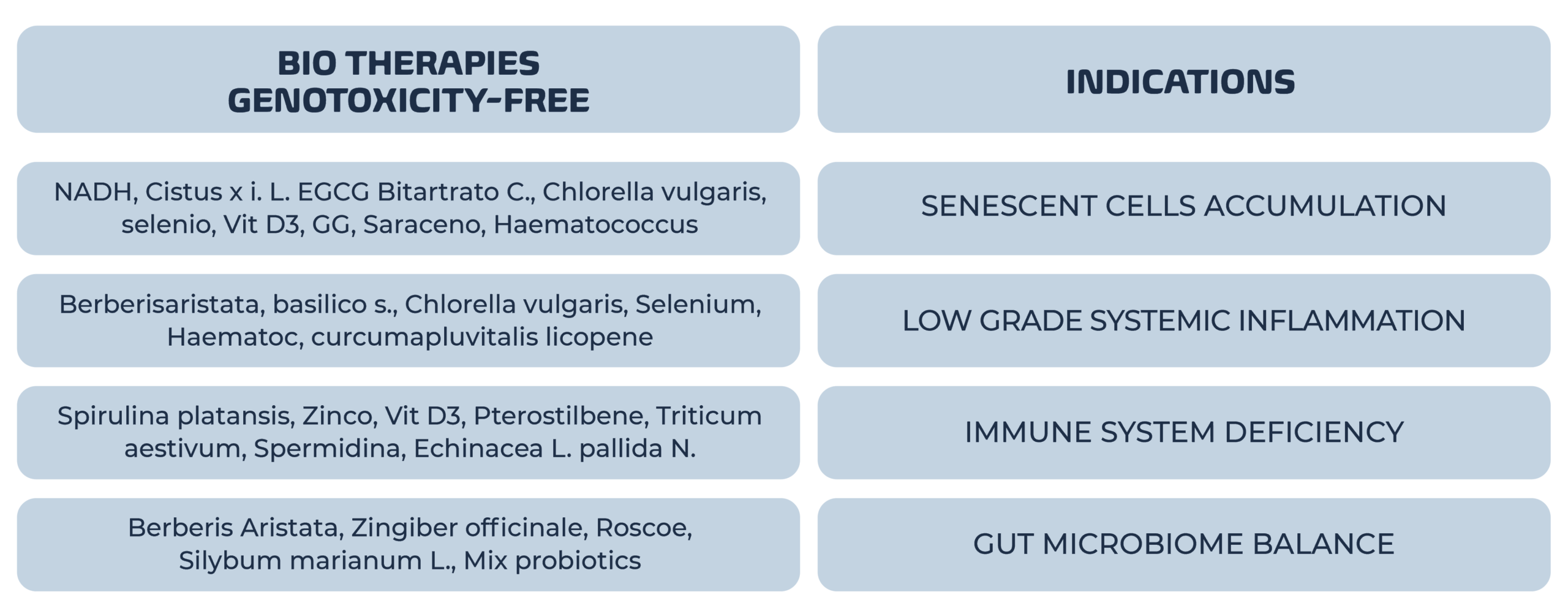
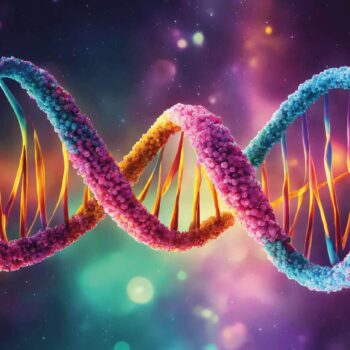
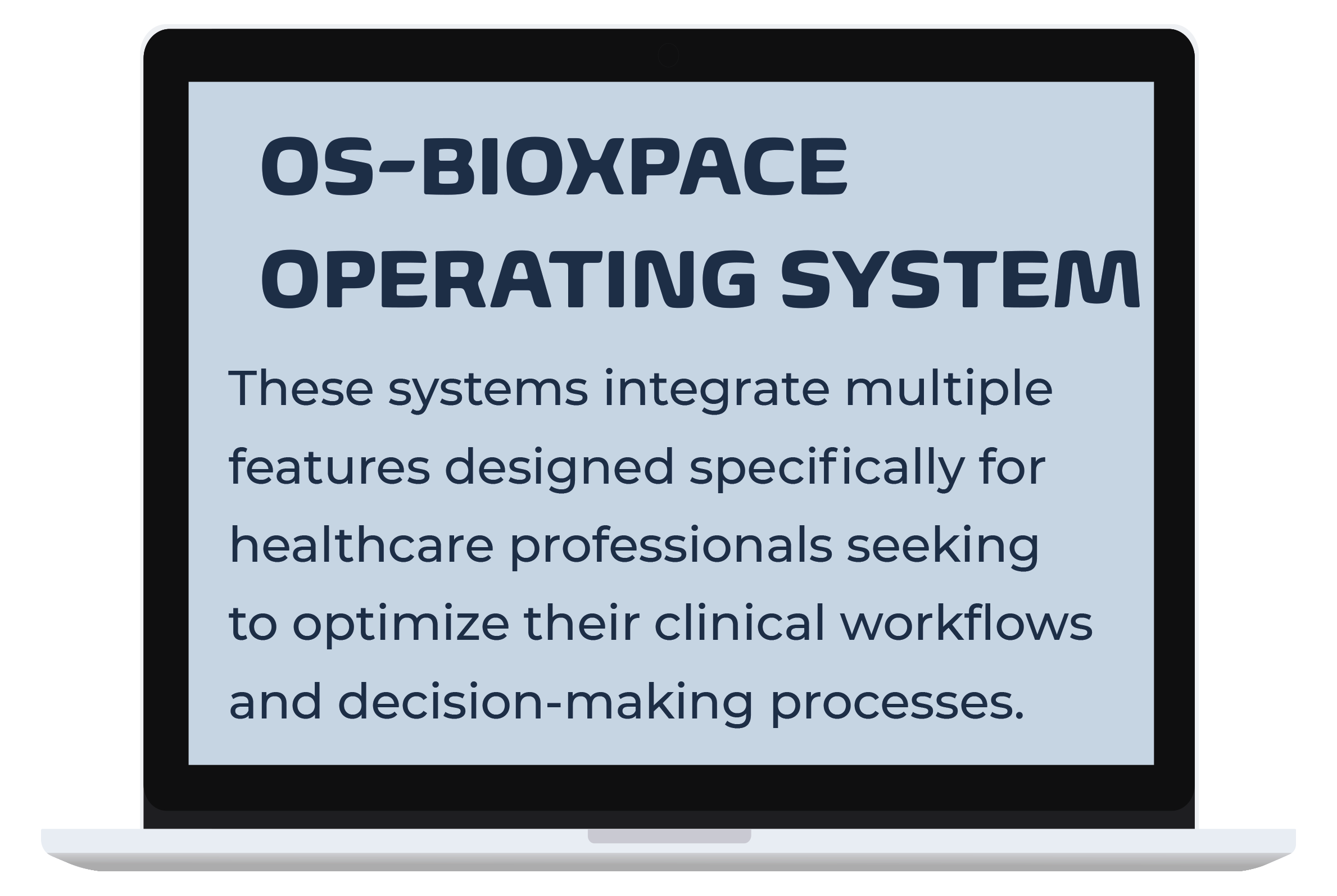
CDSS CLINICAL DECISION SUPPORT SYSTEM
Analyze patient data against medical knowledge bases to provide evidence-based recommendations at the point of care. These systems guide clinicians to follow the workflow by suggesting diagnostic procedures and treatments.
Standard Operating Procedure (SOPs)
The Standard Operating Procedures (SOPs) guide healthcare professionals through established protocols. This standardization reduces variability in care delivery and minimizes errors.
Data Management
Robust Patient Data Collection and Management capabilities ensure information is captured accurately, stored securely, and accessible when needed.
Compliance
Automated management of Quality Agreements and Informed Consent Forms ensures complete documentation while reducing administrative burden.
Dashboards Monitoring
Interactive dashboards display vital clinical and operational metrics, allowing providers to identify trends, track outcomes, and intervene proactively.
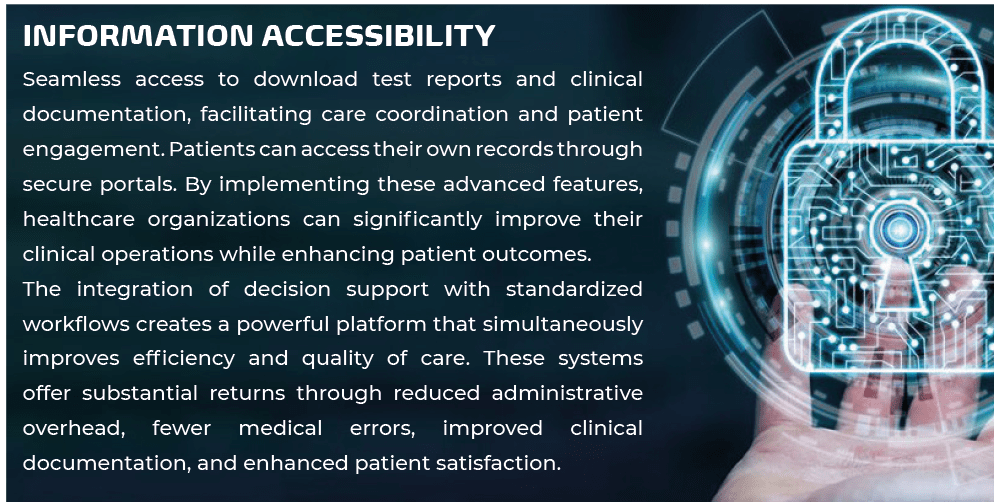
THE LIMITATIONS OF CURRENT LONGEVITY INTERVENTIONS: ADDRESSING SYMPTOMS RATHER THAN CAUSES
In the quest for a longer human lifespan and a better quality of life in the following years, numerous interventions have been proposed and implemented such as Hyperbaric, numerous interventions have been proposed and implemented such as Hyperbaric, Cryotherapy, Drip of various substances, Ozone, Oxygen, etc. Cryotherapy, Drip of various substances, Ozone, Oxygen, etc. However, a critical examination reveals a fundamental limitation: most interventions target However, a critical examination reveals a fundamental limitation: most interventions target the visible manifestations of aging rather than its underlying biological mechanisms.

THE BIOMOLECULAR GAP
Current approaches to aging primarily focus on symptomatic relief rather than addressing the fundamental biomolecular drivers of aging, such as genomic instability, telomere attrition, epigenetic alterations.
These core mechanisms, which are the “root causes” of aging, accumulate damage at the cellular level over time. Current interventions can only delay or mitigate age-related decline rather than fundamentally altering the trajectory of aging.
There is a significant gap between the targets of current interventions and the underlying mechanisms of aging, limiting the overall efficacy of these approaches, regardless of adherence or early implementation.
For significant advances in longevity research, there is a need to shift focus toward interventions that directly target these cellular aging mechanisms through genetic, epigenetic, or advanced pharmacological methods.

